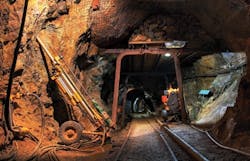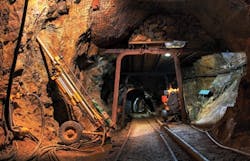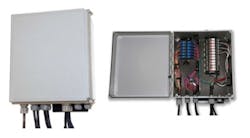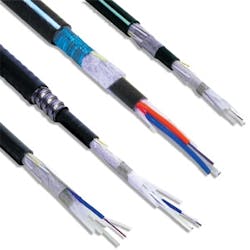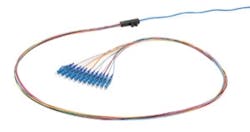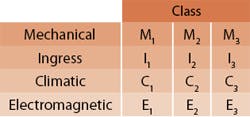Fiber-optic cabling in strange and unusual places
From the September, 2012 Issue of Cabling Installation & Maintenance Magazine
Many of the unusual environments in which you find fiber-optic cabling are physically demanding on the infrastructure and require it to have rugged physical characteristics.
By Debbie Reed and Clay Franklin, Corning Cable Systems
Most consumers give little thought to the manufacturing process needed to produce the product they’ve purchased, whether it’s orange juice or gasoline at the pump. The manufacturer is most concerned with getting the product out the door in the most efficient, reliable manner possible. Someone boarding a train only cares that they arrive at their destination on time. The transportation provider only cares that their system runs consistently and safely without costly downtime or tragedy.
As we enter the third industrial revolution, the entire system must be interactive, integrated and seamless. A reliable infrastructure is critical to ensuring that all of this happens without disruption. Generally, harsh-environment applications can subject the fiber plant to extremes in temperature, vibration and shock. Because of the environment’s “muck-and-yuck” nature, special consideration must be made in selecting the necessary components to meet the mechanical and abrasive demands of the harsh environment in which the infrastructure must operate.
When selecting these components, there are multiple aspects to keep in mind to ensure the viable environmental synergies necessary to the longevity of the network. Of these, the most important things to understand and consider are the industry standards, such as ANSI/TIA-568, which covers Commercial Building Telecommunications Cabling and ANSI/TIA-1005-A, the Telecommunications Infrastructure Standard for Industrial Premises. These industry standards give us guidance on what (products), where (locations), and how (applications).
In the industrial premises ANSI/TIA-1005-A standard, the four levels of environmental classifications are mechanical (M), Ingress (I), climatic/chemical (C) and electromagnetic robustness (E)—or in short, MICE—which defines the different environments. Each category has three numerical classifications (1, 2 and 3), which indicate the severity of environmental extremes. For example, a commercial building’s classification is typically m1I1C1E1, while an industrial manufacturing facility such as those found in mining and petrochemical plants holds the harshest environmental classification, m3I3C3E3.
After reviewing the standards, the network designer and/or end user must then specify the network system design that best meets their overall long-term needs. There are two different types of solutions that can be used when designing a system within a harsh environment: field-terminated or preterminated solutions.
Field-terminated solutions
The traditional field-terminated solution is a hands-on craftsman method. This solution allows more installation flexibility but also requires a skilled-labor team, as well as additional equipment and time during the installation process. The three primary components to this solution are cable, hardware and connectors. Each component must meet or exceed the applicable industry standard to ensure long-term reliable performance.
Tray-rated optical cables are specifically engineered for harsh environment installations. These cables have an increased tensile load along with higher impact- and crush-resistance than standard cables. Additional mechanical protection can be provided to the cable by including a corrugated or interlocking-armored layer to the cable construction. These robust cables are manufactured with flame-retardant materials, most prevalently with low-smoke/zero-halogen (LSZH), which for safety reasons minimizes hazardous smoke emissions in the event of a fire. They also conform to certain harsh environments, such as mining and petrochemical manufacturing applications that require the fiber-optic cables to be rated for temperature extremes (-50 to +75 degrees Celsius or -58 to +167 degrees Fahrenheit).
When identifying the hardware to use in a harsh environment installation, the designer must still refer to the standards for what should be used. Harsh-environment fiber-optic hardware is IP (ingress-protection) and NEMA (National Electrical Manufacturers Association) rated to the amount of protection they provide to the components installed inside them. For example, the harsh-environment fiber-optic hardware pictured below is rated NEMA 4X or IEC IP66, which means the inside of the housing is completely sealed and protected against rodent infiltration, air-blown dust, water ingress, accidental contact with equipment, extreme weather conditions and/or corrosive agents. Infiltration into the housing from any of these environmental hazards could result in costly downtime or even worse, a serious health and safety threat to those working in the area, should the manufacturing process be suddenly disrupted because of network failure.
The final aspect of a field-terminated solution would be considerations such as connectors (epoxy-and-polish or no-epoxy/no-polish), splice trays, heat shrinks and the buffer tube fan-out kits used in terminating the loose-tube cables. These interior components are all protected by the ruggedized, environmentally protected fiber-optic hardware, but still play a major role in the viability of the solution. Also, keep in mind that there will be many different (and sometimes costly) types of tools needed to complete a field-terminated installation, such as connector installation toolkits and/or fusion splicers. And as previously mentioned, these tools require a qualified, experienced technician.
Preterminated solutions
Unlike the traditional field-terminated solution, the preterminated or factory-terminated solution requires more upfront work during the design phase. Each connection point must be precisely measured from tip to tip. With preterminated solutions, the design must be exactly right on the money with where everything is going to go. The factory customizes the preterminated solution based on provided length measurements. Once the system is manufactured, there isn’t a way to access the cables in the field without destroying the pre-engineered integrity originally desired from a factory-terminated and -tested solutions.
However, the benefits of a preterminated system can far outweigh these factors. Deploying a preterminated factory solution dramatically saves time and money during installation, which is a must if the facility is already operational. As such, it minimizes risk and maximizes overall return on investment by maintaining a productive work stream in the facility. The major components of preterminated solutions are often largely similar to the field-terminated solutions with flame-retardant and/or LSZH cables used in both solutions along with some of the same types of hardware.
Which is best?
The key difference between field-terminated and preterminated solutions is in the controlled environment where the termination and testing takes place. With preterminated solutions, peace of mind comes from having these processes performed in a controlled environment, while being able to provide the highest quality insertion/return loss and performance. With a field-terminated solution, it is dependent on the installer the day of the install combined with the conditions in the harsh environment. A factory-terminated solution reduces installation time, human variability, and error. This type of solution requires knowledgeable designers and estimators upfront, but without the trained craftsman labor to do the install. Also, the capital investment for connector installation kits and fusion splicers is not required with a preterminated solution.
Although preterminated solutions sound like the definite way to go, they may not necessarily be the ideal option for every installation. Preterminated solutions meet a very specific set of needs, as do field-terminated solutions. Both options are viable solutions when installing in the harsh environment. Ultimately, it all boils down to what the end user needs.
Installation best practices
When looking at best practices while installing fiber-optic systems in any environment, safety should always come first. The working conditions of installation in a harsh environment will be less than ideal. The installer must be aware of what’s going on around them at all times. The rugged and potentially hazardous nature of their work area can affect the quality of the install, not to mention their physical safety.
Adherence to industry standards should be a guide for all installers and designers to consider when performing their respective jobs. Cable pulling or placement should be performed to industry standards as well as the standard recommended procedures (SRP) and installation guides provided by the cable manufacturers. The same goes for installing hardware, connectors and fusion splicing—all industry standards and manufacturer recommendations must be followed.
In a harsh environment, proper cleaning is a concern and is the most common cause of network downtime and errors. Whether deploying a field-terminated or preterminated solution, it is vital that all connectors are properly handled and cleaned during the system’s installation and before mating any connector. The slightest dust particle or chemical debris can greatly affect the overall performance of the network. Tools, such as port cleaners and connector cleaning cassettes, can make the task much more efficient and easier than other methods. Finally, both solutions should be tested in accordance with TIA-568-C.0 for compliance and network integrity. A key takeaway from this article should be that fiber-optic connectors should be clean, especially in harsh environments.
So the next time you take a sip of orange juice, pump gas into your vehicle or even if you’re boarding a train, think about everything that ultimately made that product what it is. A big part of its journey depended on an interactive, integrated and seamless network infrastructure in its “muck-and-yuck” manufacturing process. With careful planning and selecting the right fiber-optic product solution, the network infrastructure you install today will stand up to the mechanical and abrasive demands of the harsh environment in which it must operate far into the future. ::
Debbie Reed is marketing communications specialist and Clay Franklin is marketing specialist with Corning Cable Systems (www.corning.com/cablesystems).
